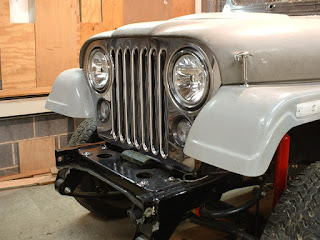front of the radiator was the deciding factor on how deep we could go. Started by duplicating and cutting the shape in the bottom of the pan. The mounting flange in the grille was then cut out along with the flange in the chrome overlay. The overlay flange was then welded into an M38A1 bucket that was sectioned down to 1" depth. This bucket was then welded to the back of the grille in place of where the flange was removed. This has to be indexed perfectly so that the bulb is in a vertical position. The chrome overlay is put in place followed by the cake pan trim ring then finally the the
bucket assembly that holds the bulb then screwed through into the welded shortened M38A1 flange. Only then can the stock trim ring be fastened. This gives us enough clearance attaching the plug to the back of the halogen lights. These light by the way are Rampage #5089925 using H4 bulbs. http://www.rampageproducts.com/Catalog/Page33.html
Ok,so here is how we
frenched the turn signals. The clearance from the back of the grille to the front of the radiator again was the deciding factor on how deep we could go. We ended up buying clear JK turn signals and along with a 5" dia. x 1 1/4" deep pie pan from the local Kitchen Supply store used as a combination trim ring and mounting pod, the bottom of the pan was cut out with a 3 1/8" hole saw in a drill press. Then 3 slots were cut in using a cut off wheel to coincide with the 3 molded in ribs on the JK housing. The 2 plastic mounting tabs were cut off the back of the JK housing and 2 holes drilled for #8 screws that
were installed from inside the housing by removing the bulb socket and secured with nuts on the outside. On the grille the original holes were cut open with a 4" hole saw by attaching a steel plate from the backside and a 1/4" center hole to guide the hole saw pilot drill. A bracket was bent up to attach the whole assembly, the same as what is commonly used for mounting many instrument gauges. But these brackets were welded to the back of the grille. The assembly can be slid through from the front with the #8 screws through the bracket and fastened with 2 nuts. So far I have not been able to find
stainless steel 5" pie pans, if I don't then these will have to be chrome plated. I can only say my wife keeps wondering my interest in kitchen supply stores. Good to keep them guessing.




















